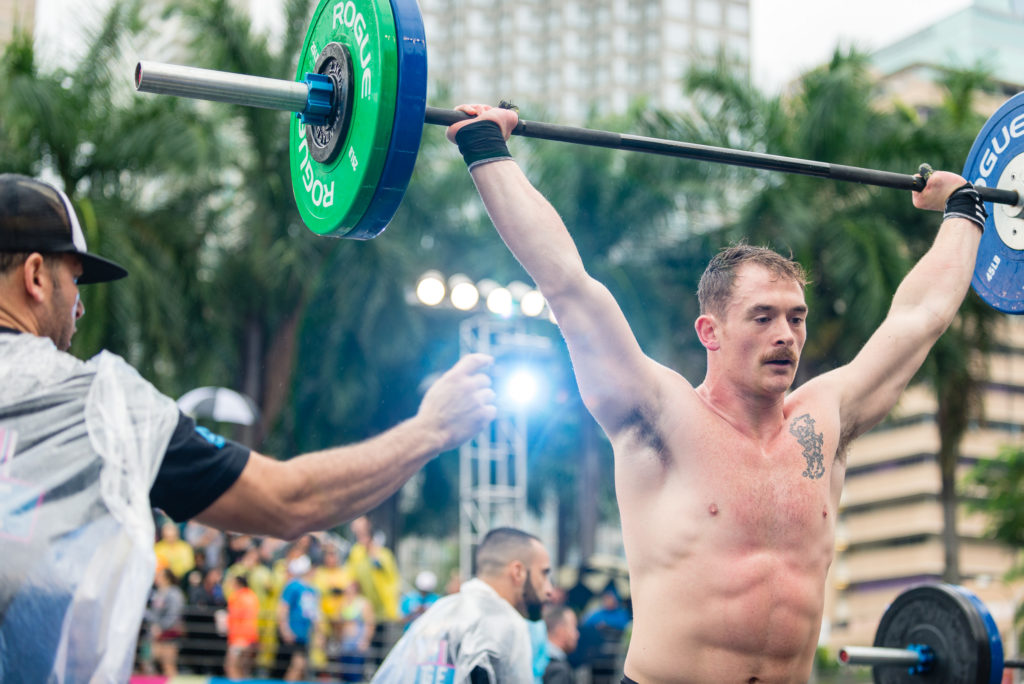Are You Strong Enough to go to the Crossfit Games?

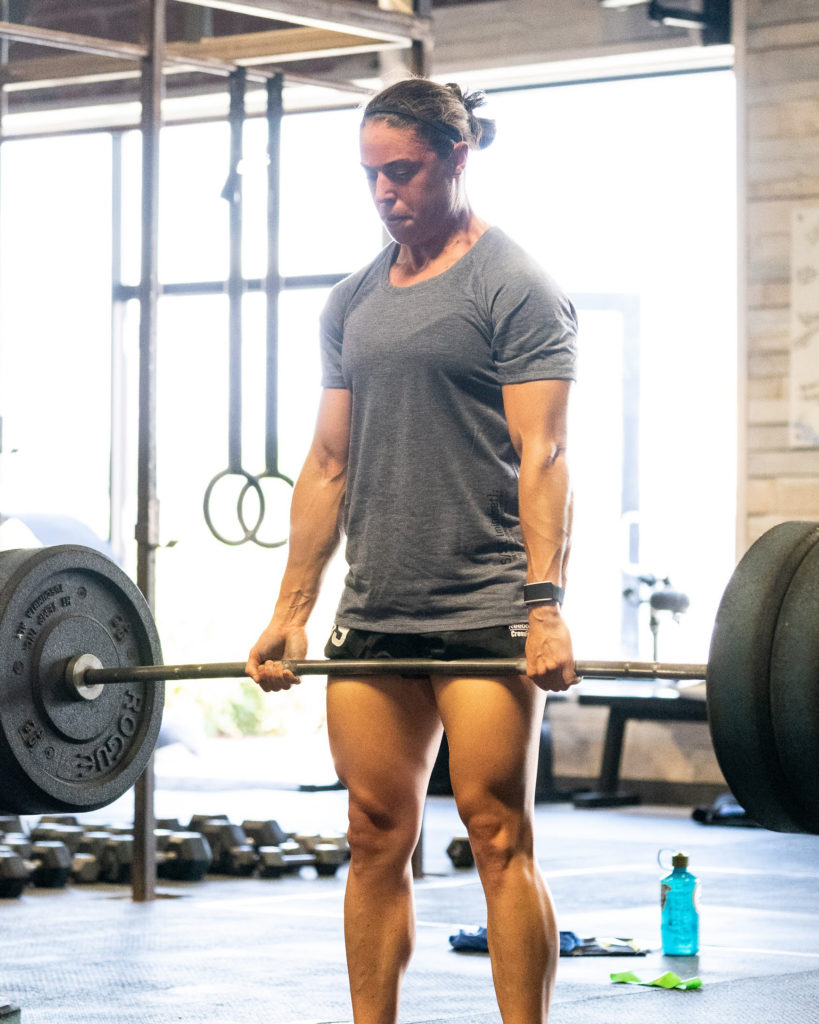
As the name implies, the test to find the fittest man and woman on earth is in fact a test of fitness. With many athletes chasing bigger lifts rather than improved conditioning scores, anyone who wants to compete at the highest level inevitably says to themselves “I’m just not strong enough”. As a coach who preaches the need for the majority of his athletes to improve their fitness – that is, their metabolic conditioning, it’s important for all of us to be on the same page with regards to just how strong an athlete needs to be to meet their goals. So, you want to go to the CrossFit Games, do you? How strong do you really need to be to qualify for the CrossFit Games? The answer, as it turns out, is just strong enough. Now don’t get me wrong, you have to be pretty fucking strong, but you certainly don’t have to be the strongest, and if you made it to the Games on “average” strength numbers for the field, you could actually find yourself fairly high up the leaderboard if your engine can support it. The bottom line is that there are some pretty set numbers you’ll want to have when it comes to your strength just to get a seat at the table. But if qualifying for the Games is akin to making the final table at the World Series of Poker, you just need to get yourself there to give yourself a shot at finishing in the money.
Before we dive into some data, we need to talk about what it means to be “strong”. Unlike sports like powerlifting or weightlifting, CrossFit rewards athletes much more if they have the capacity to move anywhere from light (20-40% of their 1RM) to moderately heavy (75-85% of their 1RM) weights many times. Maximal strength as it’s most commonly defined, is the ability to generate maximal force once, and lends itself to big 1RMs. “CrossFit Strength”, on the other hand, is more similar to strength-endurance or stamina, where athletes are better suited and rewarded for their ability to move 70-90% of their 1RM multiple times depending on muscle fiber breakdown, athletic background, gender, etc.. Power based athletes, or athletes with more fast twitch muscle fibers will usually have impressive 1RMs, but are more likely to tire quickly after multiple reps. Endurance based athletes have more slow twitch muscle fibers, slightly lower 1RMs, but can move 90% of their 1RM 5-7 times whereas a power athlete may only be able to conjure up 2-3 reps at that percentage. Women tend to fall more into the latter category and is a big reason we see them perform better in a solid number of barbell workouts. That’s an entirely different rabbit hole that also includes data points like pain tolerances, neuromuscular efficiency lactate threshold, and more, but we’ll save that for another time.
When it comes to testing strength in CrossFit, of the 13 or so events we usually see tested at the CrossFit Games usually only 1 or 2 test an athlete’s true, raw strength, usually in the form of a 1RM lift and/or a speed ladder. In 2020, even those events can hardly be viewed as true tests of pure strength, as the CrossFit total was still the third event on day 1 after a grueling 2007 Reload and painful 320m Cornsack Sprint. The snatch speed ladder certainly requires power, but also a degree of fitness tested only in CrossFit where successful athletes have to lift huge percentages of their 1RMs multiple times with minimal rest. As an example, Jeffrey Addler won the CF total in 2020, but finished in either 4th or 5th place in every other event on day 1. We all remember Sam Dancer’s insanely impressive 615lb deadlift in 2016 at the Ranch, but let’s not forget it was immediately following a last place finish in the Trail Run, and part of a 32nd place overall finish on the weekend. All of these concepts and stats beg the question: just how strong do you need to be to go to the CrossFit Games?
Averages and Data
To answer this question, we took data from 2018 and 2020 and compared minimum and average strength requirements of four lifts: the snatch, clean and jerk, back squat, and deadlift. We omitted 2019 is of the format of the Games and the sheer number of athletes who qualified as a result of the national champion component that was put in place. By using 2018 and 2020, we have a similar pool of athletes to use for comparison and a more controlled route of qualification. For anyone interested, we’ll include a link to all the tables and numbers from each athlete at the end of the article.
A note on the data: data was primarily acquired through the CrossFit Games website. That being said, there were some questionably low numbers which prompted some additional research to verify and have updated the data accordingly (e.g. Roman Khrennikov has a listed 220lb snatch and 286lb clean and jerk on the Games website, but has snatched 242lbs and clean and jerked 343lbs in recent competition).
Out of the 113 male and female athletes who competed, 6 athletes had incomplete data (missing 1 or more of the lifts measured), and 22 of them had no data for any of the 4 lifts measured. It’s also understood that some of the numbers may not be fully up to date, but through experience coaching some of these caliber of athletes as well as a little additional online research, we can say that the variance is not drastically off. So without further ado…


If you wanted to be reasonably competitive at the CrossFit Games in either 2018 or 2020 (we can safely say 2019 as well) by having average lifts amongst your fellow competitors, you would have wanted to have somewhere close to the following max lifts, written as male/female.
- Snatch: 285/188lbs
- Clean and Jerk: 348/230lbs
- Back Squat: 453/297lbs
- Deadlift: 528/353lbs
Now, those are AVERAGES, with the minimum strength requirements being significantly lower. The good news for you is that you don’t necessarily need to hit these averages to qualify for the Games, but the closer you find yourself to these numbers the better shot you have at placing reasonably well at the Games. That is of course, assuming your engine is on par with your strength. So if these are the averages, what are the minimums?
Male Minimums and Outliers
Roman Khrennikov for men has a listed 1RM snatch of 242lbs, with the next lowest snatch belonging to Luke Schaffer at 264lbs.
Pablo Chalfun, who placed 38 of 38 in 2018 has the lowest listed clean and jerk at 305lbs with the next lowest clean and jerk coming from 2020 22nd place finisher Luke Schaffer at 315lbs.
Elliot Simmonds (28th in 2018) and Cody Anderson, who still finished in a very solid 10th place in 2018 report the lowest back squat number at 405lbs each with the next highest squat only 10 pounds heavier at 415lbs. Note that Cody Anderson has stated to have hit a 390lb front squat as recently as 2019, so it’s like that his back squat is higher despite only weighting around 170lbs.
Ethan Helbig and Roman Khrennikov hold the lowest reported deadlift numbers at 455lbs and 462lbs, respectively.
It’s safe to say that if you’re a male wanting to qualify for the Games, a 265lb+ snatch, a 315-335lb clean and jerk, a 415lb (likely more like 435lb+) back squat and a 455lb deadlift are your bare minimums needed to even be in contention for a ticket to Madison.
Female Minimums and Outliers
On the women’s side, our spread is a little tighter with our lowest reported snatches coming at 160-165lbs, but with bigger names like Chyna Cho reporting only slightly heavier at 170lbs.
Our lightest clean and jerk (198lbs) comes from Oddrun Eik Gylfadottir who finished 28th at the 2018 Games, and who also had the lowest reported snatch at 160lbs. Other notably light clean and jerks include Haley Adams (205lbs) despite finishing 4th in the 2020 Games.
Our lowest back squat numbers come are in the 250-260lbs range, with Haley Adams again reporting only a 255lb back squat despite her overall spectacular 2020 performance (this back squat may actually be fairly accurate, as she hit a 230lb 1RM Front Squat as part of Stage 1 qualification this year).
Lastly our deadlifts, which at lowest hover at 295-300lbs but gradually increase from there. Haley Adams again reports one of the lowest deadlifts at 300lbs, but is in good company with 2018 10th place finisher Cassidy Lance McWherther (295lbs) and 2014 Champ Camille Leblanc Bazinet (300lbs).
If you’re a woman looking to qualify for the Games, you’re looking for a minimum 160-170lb snatch, a 205lb+ clean and jerk, a 300lbs+ back squat, and a 310lbs deadlift or more to be safe. Again, keep in mind that these reported numbers are more likely to be low than high, so the farther north of these minimums you can be the better your odds are of being competitive.
Men Top 10 vs. The Rest
To most, it would seem logical that the stronger you are the more likely you are to do well at the Games. While being strong can certainly benefit you, the trade off in having lifts 5-15 pounds above the average won’t matter all that much unless you have the engine to back it up. In 2018, Royce Dunn won the CF Total Event but finished the weekend in 34th overall. In the same year, Jared Enderton (who has the strongest listed snatch and back squat, and the highest overall total of the four lifts measured) took 5th in the CF Total, 2nd in the Clean and Jerk Speed ladder, but finished 35th overall.
Tables 3 and 4 below give a better picture of the differences between the average 1RMs of the Top 10 men and the rest of the field in 2020 and 2018, respectively. The “overall average” row indicates the average 1RMs for the entire field of mean for that year, where the “Top 10” and “Places 11-30 or 39” are the averages for those respective final leaderboard placings. There is a fairly large disparity for the 2020 field of men, where having a 1RM that was anywhere from 10-20 pounds (or more in the case of the deadlift) above the rest of the field was likely to place you higher on the leaderboard.
In 2018 however, as shown in Table 4, that wasn’t true. In fact if you look at the far right column (“Total” – the sum of the 4 lifts measured), the top 10 men had below average totals, and the bottom 30 men had an above average totals. This is an interesting phenomena consider that the CrossFit Total was the third event of the weekend in both 2018 and 2020. The most logical reasoning for this is that there were only 5 men to perform the total in 2020 and 39 men who performed the CF Total in 2018.
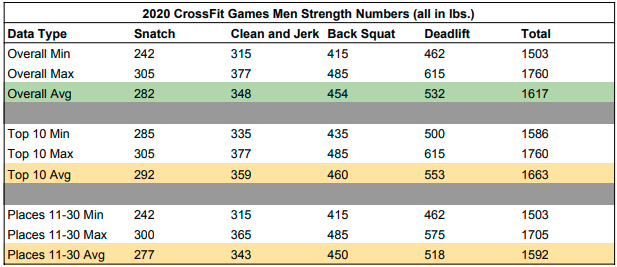
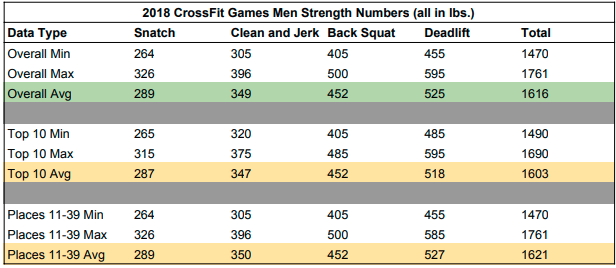
Women Top 10 vs. The Rest
The story on the women’s side seems to fall a little more in line with what you’d expect to see, and this is likely because there are far fewer female outliers (women who have significantly higher or lower 1RMs compared to the rest of the field) than on the men’s side. This is likely due to the propensity for women to be better suited toward CrossFit Strength as opposed to maximal strength as a result of lower neuromuscular efficiency and less testosterone.
In 2020 the majority of the female field was remarkably similar in strength, with the most significant difference being in the deadlift where top 10 women had, on average, a 16lb heavier deadlift than women who finished in the bottom 20. Otherwise, as long as you hovered within 5 pounds or so the average 1RM snatch, clean and jerk, and back squat, you had just as good of a shot as anyone to crack the top 10.
The story in 2018 was a little more spread out but still relatively close, where women who finished in the bottom 30 lifted between 5 and 7 pounds less in each respective lift than women who finished in the top 10, as shown in table 6.
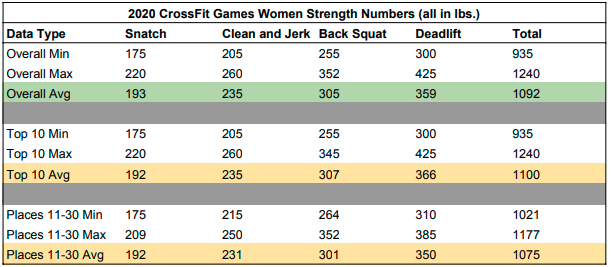
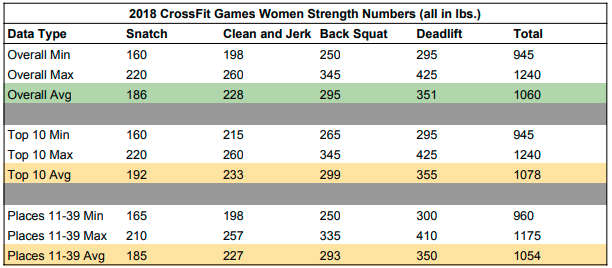
Getting there
We probably don’t need to tell you, but simply dropping everything you’re doing and starting a strength/olympic lifting program in an effort to solely improve your 1RMs isn’t necessarily the right move. As the data shows us, it doesn’t pay to be the absolute strongest athlete on the field, but there is a certain level of strength that is required to sit at the table. When thinking about how to make that leap, step one is understanding whether you’re more of a power-based athlete or an endurance based one, with step two being how to adjust your training vs. testing strategies accordingly.
When it comes to improving strength, power athletes need fewer reps at moderate or high percentages of their 1RM (too many heavy reps can be detrimental to these athletes’ central nervous system and ability to recover), and generally need to improve their aerobic engine so that they can more comfortably move moderate weights at a steady pace. In testing (e.g. competition or qualifiers) power based athletes tend to perform better by starting workouts strong and by slowing down throughout, rather than trying to maintain the same pace from the start. From a training perspective, that means power athletes will benefit from practicing the opposite – trying to get comfortable holding a single, slow to moderate pace for an extended period of time, or by working on things like negative splits and paced aerobic work.
Endurance based athletes on the other hand will require more repetitions and can usually do so at higher percentages of their 1RM to elicit a strength response. Again, think about athletes you know whose 1RM may not be super impressive, but who can perform reps at 90% for twice as long as their power-based counterparts. In training, these athletes have to do what they can to improve their top end output by going very hard for lots of short bursts, e.g. lots of :10 sprints on an Assault Bike for max wattage. They will also benefit from lifting at high percentages of their 1RM – moreso that we might expect from the average athlete. In testing or competition mode, these athletes can take advantage of their ability to hold a higher average output for longer than their power-based counterparts, and shouldn’t get baited in to trying to play catch up should they see their competition start an event at a faster pace than they do.
Back to Work
It’s a double-edged sword, really. Ultimately, the Games are a test of general physical preparedness, but based on the data presented there is in fact a minimum strength requirement to compete at the highest level. What comes next is the million dollar question: do you temporarily sacrifice overall GPP to improve maximal strength, or do you continue executing a well-rounded GPP program that biases your weaknesses? As with any meaningful question, the answer is rarely black and white and this is no exception. Our propensity, however, is toward the latter. In our experience there are very few athletes who are so incredibly far in one direction or the other that the complete omission of GPP is needed or smart. If we were to try and put the two ideas in circles and create a ven diagram, the two would heavily overlap. Louie Simmons, the founder of Westside Barbell and arguably the strongest gym in the world is a massive advocate of GPP for both his powerlifting specialists and elite athletes seeking his expertise.
Chasing the averages outlined in this article cannot come at the expense of your overall engine and work capacity. Yes, having a bigger back squat will make doing Fran easier, but only if you have the capacity to support being able to move those lighter weights faster and for longer, and the aerobic engine that facilitates both active and inactive recovery. At some point, the return on improved maximal strength no longer enables you to outperform your fitter competitors, and it will come as no surprise to anyone that based on the data you’ve just read, the fittest athletes will always come out on top. A program that enables you to improve your GPP while biasing any strength deficiencies you have is your ticket to the top, so don’t take this article as a license to become a weightlifter for a few months. Instead, might I recommend Misfit Athletics?
Written by Hunter Wood


